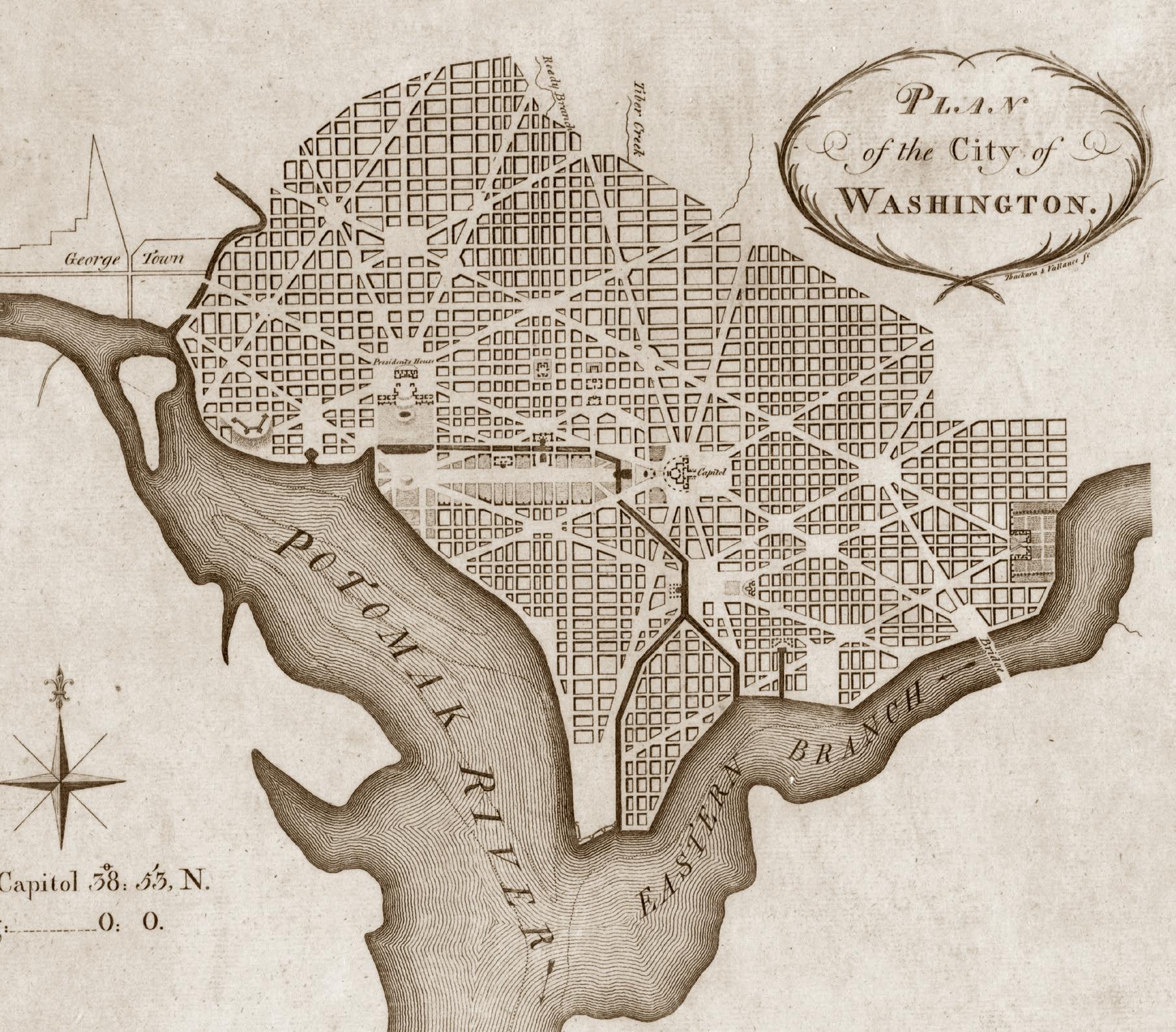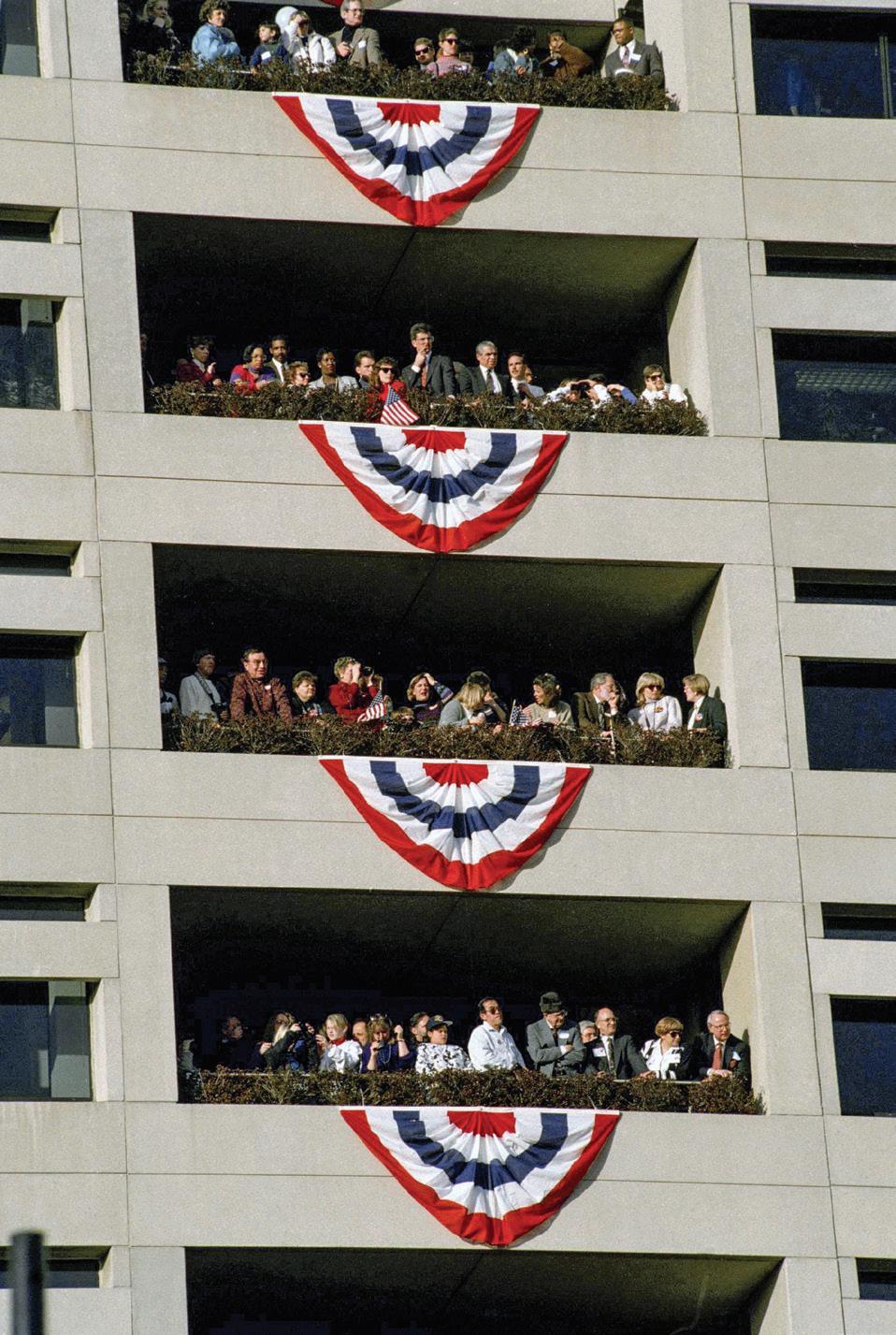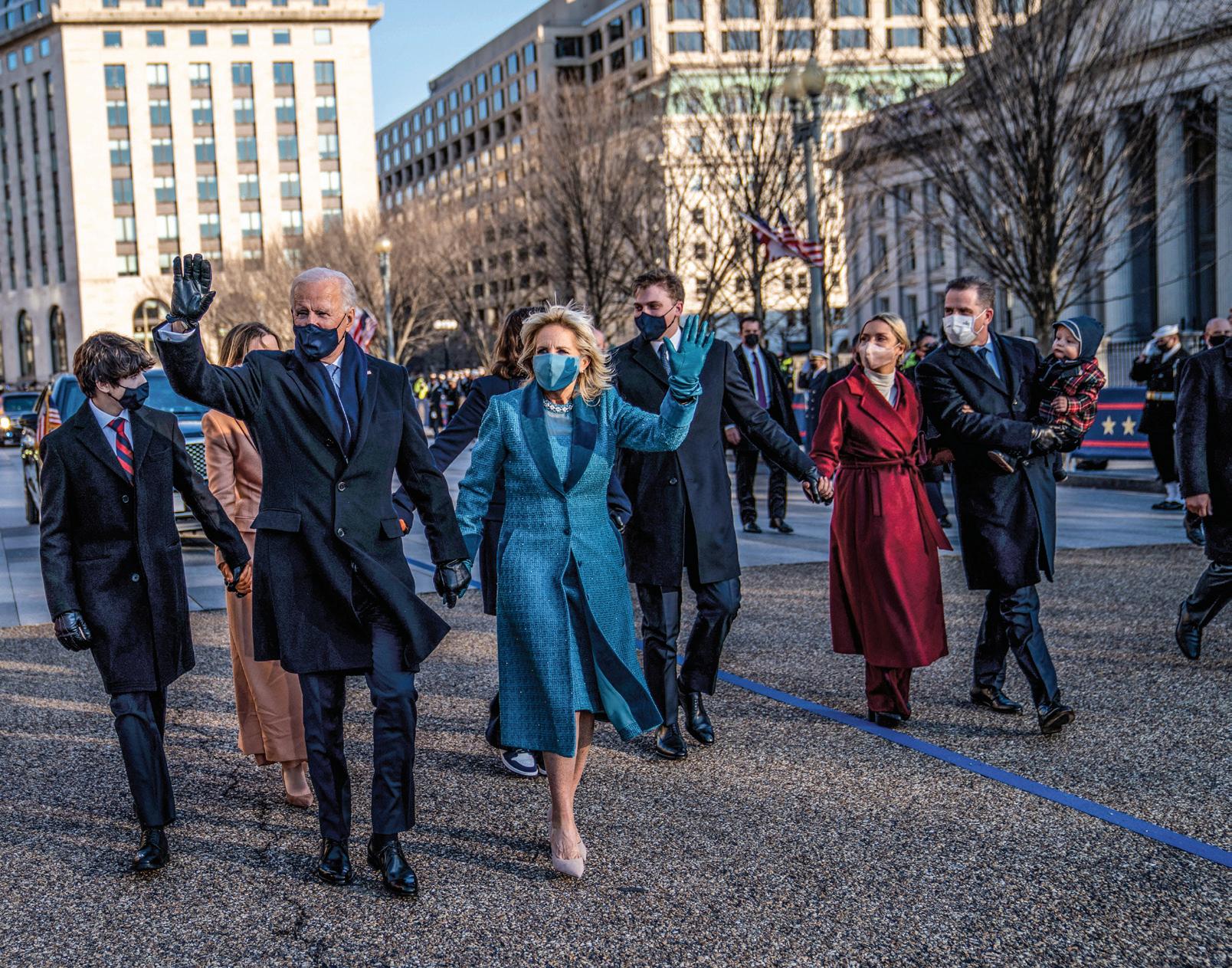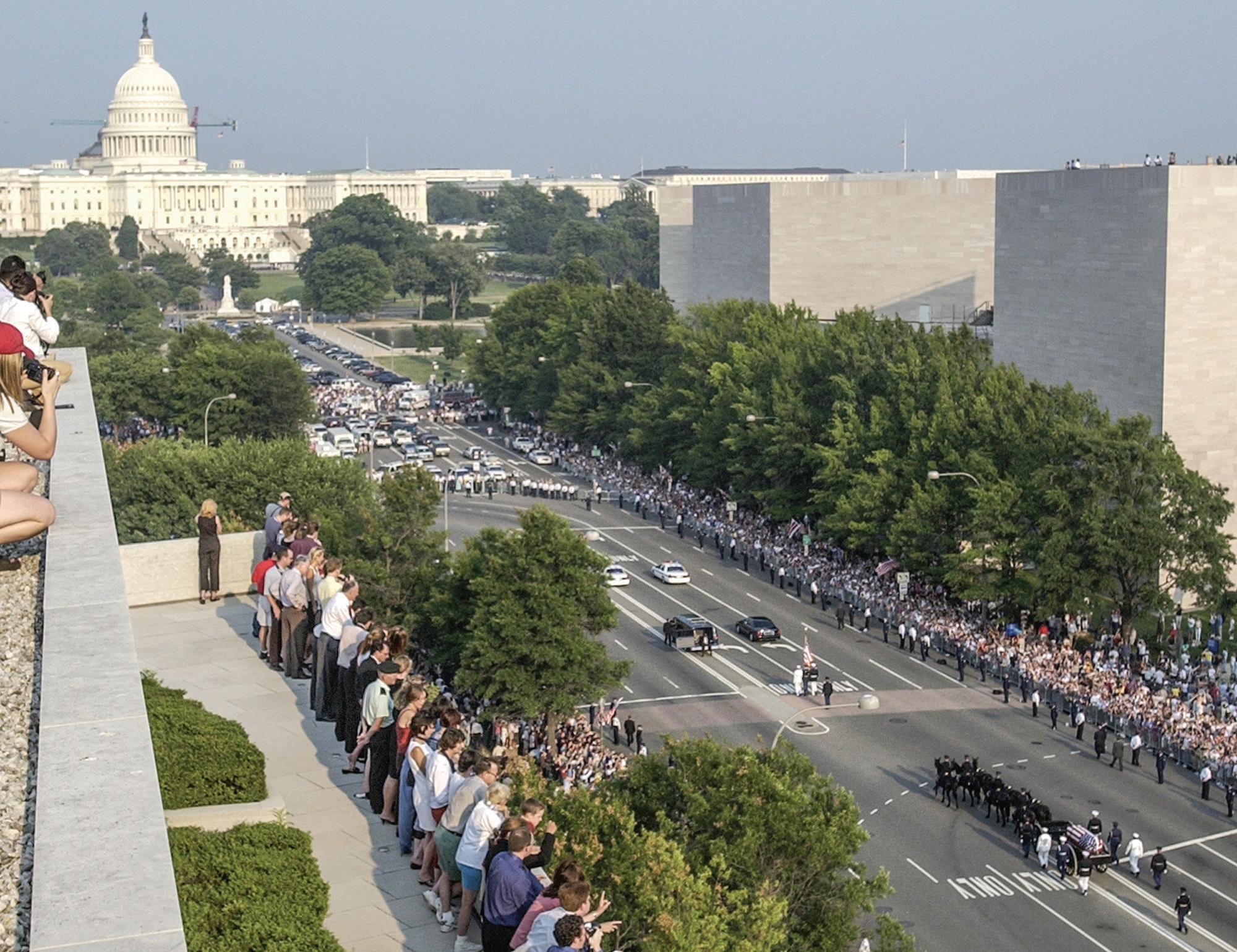Pennsylvania Avenue THE WHITE HOUSE
JENNIFER I. WOJECK
the famous address “1600 pennsylvania avenue,” so often heard during the presidential inaugural season, immediately brings to mind scenes of long-standing traditions, both followed and broken, as the president-elect officially becomes the president of the United States. Connecting the U.S. Capitol to the White House, Pennsylvania Avenue has fittingly been called America’s “main street” and the nation’s “red carpet.” It is the road that often carries an outgoing president on a final ride from the White House to the Capitol and an incoming president on a first ride as president from the Capitol to the White House. From President George Washington, who saw the envisioned, and yet to be named, avenue on the first city plans, to the twenty-first-century presidents for whom the gates at 1600 have opened, every president’s experience has included Pennsylvania Avenue. From the vantage point of the White House, the presidents have watched more than two hundred years of history unfold; they watched as a city rose and grew, and as America celebrated and protested. The following pages offer a glimpse of the wealth of history held in the blocks of the presidential site known as Pennsylvania Avenue.

Pierre Charles L’Enfant’s original plan for the City of Washington shows his concept for a grid of streets running east to west and north to south, intersected by diagonal avenues. Yet unnamed on L’Enfant’s 1791 plan, a plan published in 1792 shows that streets running east to west are identified by letters, streets running north to south are identified by numbers, and the diagonal streets are named for the states of the Union.
The 1792 map identifies the avenue connecting the White House with the Capitol as Pennsylvania Avenue. Architectural Historian Pamela Scott suggests that when a state name was chosen for the avenue connecting the President’s House to the Capitol, it is possible that Pennsylvania was given the honor because of its importance in the early history of the United States.1 The significance of this particular avenue is evident in the priority given to its development as expressed in a November 17, 1791, letter from then Secretary of State Thomas Jefferson to the Commissioners of the City of Washington:
The street most desireable to be built up at once, we suppose to be the broad one (the avenue) leading from the President’s house to the Capitol. . . . The President therefore desires me to suggest to you the beginning at once on that avenue.2
A decade later, Jefferson himself was president. He remained interested in the beautification of Pennsylvania Avenue, building an arch-oftriumph entrance gate3 and lining the street with poplars.4 The avenue was “not cut across” in front of the White House until a little over a decade after Jefferson left office.5 This created the portion of Pennsylvania Avenue that runs in front of the White House from Fifteenth Street to Seventeenth Street. As seen on a map made in 1840, this arrangement varies slightly from L’Enfant’s plan, in which Pennsylvania Avenue did not cross in front of the President’s House but simply stopped at and started on either side of the President’s Park. Jefferson’s 1805 Inauguration marks the
previous spread
The 2001 Inaugural Parade moves west on Pennsylvania Avenue as President George W. Bush watches with his family and friends from the reviewing stand erected in front of the White House.
left and opposite Pennsylvania Avenue, the diagonal street linking the President’s House with the Capitol, is not yet named on L’Enfant’s 1791 Plan of the City of Washington (left). A facsimile of an engraving of the city plan made by Samuel Hill in 1792 identifies the avenue as Pennsylvania (opposite, top). A map made in 1840 shows the avenue cut on the north side of the White House connecting Fifteenth Street to Seventeenth Street (detail, opposite, bottom).
beginning of a ceremonial role for Pennsylvania Avenue. Jefferson rode on horseback from the White House to the Capitol to take his second Oath of Office. On his return a spontaneous parade formed as spectators joined in the walk. More formal Inaugural Parades soon became a tradition in the nineteenth and twentieth centuries and continue today.6
As the images that follow reflect, Pennsylvania Avenue evolved as the city grew. The thousands of photographs of each successive Inauguration from the late nineteenth century to the present document that evolution and offer a visual history of the avenue as the presidents themselves experienced it.
left and below
For more than two hundred years, Pennsylvania Avenue has evolved as the city of Washington, D.C., has grown. Thomas Jefferson, who in 1791 asked the City Commissioners to focus at once on building up the avenue, arranged for Lombardy poplar trees to be planted along the avenue in 1803. As he made his way back to the White House from the Capitol following his 1805 Inauguration ceremony, he would have seen the city emerging with a sprinkling of mainly residential buildings, as illustrated in this engraving made in 1824 (top left). By the time of Ulysses S. Grant’s 1869 Inauguration, the Capitol dome was completed, the city blocks were filling in with brick residences and businesses, and Pennsylvania Avenue was a busy thoroughfare, as seen in this 1871 view west from the Capitol toward the White House (bottom left).
right
A twentyfirst- century view captures Pennsylvania Avenue as it appears today.
Closed to motor vehicle traffic in 1995, the blocks that connect Fifteenth to Seventeenth Street are now enjoyed by pedestrians and bicyclists. The stretch of the avenue between the U.S. Capitol and the White House is lined primarily with government and private office buildings, museums, and hotels.
opposite
The 1905 Inaugural Parade for Theodore Roosevelt moves past the headquarters of the U.S. Postal Department, better known as the Old Post Office Building. Completed in 1899 by the federal government, the building now houses a luxury hotel.
right
Tracks used by the trolley cars that ran down the center of Pennsylvania Avenue for decades can be seen beneath the horse drawn carriage carrying President William Howard Taft back to the White House from the Capitol in 1909.
below
The 1917 Inaugural Parade for President Woodrow Wilson passes the J. F. Jarvis Building at 135 Pennsylvania Avenue. The entire block of buildings seen here has long since been demolished. Jarvis was a photographer known for his stereoviews of the White House and other city landmarks.
left
On the eve of World War II formations of infantry march in the 1941 Inaugural Parade for President Franklin D. Roosevelt.
below
U.S. Military Academy cadets turn left onto Pennsylvania Avenue from Fifteenth Street during the 1949 Inaugural Parade for President Harry S. Truman. This view of Pennsylvania Avenue is much the same today.
above
Crowds settle in on the sidewalk in the 600 block of Pennsylvania Avenue awaiting the start of the 1953 Inaugural Parade for President Dwight D. Eisenhower. The Zenith Building has since been demolished.
The car carrying President and Mrs. John F. Kennedy in the 1961 parade turns onto Fifteenth Street from Pennsylvania Avenue in front of the Hotel Washington. The iconic hotel, built in 1917, remains a popular location for viewing the Inaugural Parade.
right
left
President Richard Nixon’s motorcade passes the National Archives Building at 700 Pennsylvania Avenue during the 1969 Inaugural Parade.
below
President Donald J. Trump’s car passes the White House Visitor Center at 1450 Pennsylvania Avenue during the 2017 Inaugural Parade.
above
Crowds traditionally fill every accessible window and rooftop along Pennsylvania Avenue during the Inaugural Parade. Open balconies at 1331 Pennsylvania Avenue (right) offer a view for many during the 1993 parade for President Bill Clinton, while balconies at 601 Pennsylvania Avenue (left) provide an ideal vantage point to see the 2013 the parade for President Barack Obama. right
Protected by a mask at the height of the COVID-19 pandemic, President Joe Biden continues the traditional walk to the White House begun by President Jimmy Carter in 1977. President Biden is seen here with his wife, Jill, and their family as they pass the Treasury Building just east of the White House.



Although presidential Inaugurations constitute the thickest chapter of Pennsylvania Avenue’s presidential history, the presidential connections with the main thoroughfare from the White House to the Capitol do not stop there. In 1841 Pennsylvania Avenue took on a mournful atmosphere following the death of William Henry Harrison, the first president to die in office. The death of a president was not a private matter and called for a public ceremony. On April 7, 1841, invited guests gathered in the East Room for Harrison’s private funeral. The public then watched the scene under the North Portico as Harrison’s casket was placed onto a “funeral car,” a platform akin to a float, which was covered in black and embellished with wreaths. The Marine Band played a funeral dirge and fell into formation as the horse-drawn car moved down the driveway to Pennsylvania Avenue, past the U.S. Capitol, and onto the Congressional Cemetery.7 Presidential funeral processions have ever since been a traditional part of public mourning ceremonies for presidents who have died during or after their term of office.
At times the presidents have been observers of the events on Pennsylvania Avenue, rather than participants. President Andrew Johnson, for example, watched the Grand Review of the Armies in May 1865 from a specially built reviewing stand in front of the White House as, over the course of three days, several hundred thousand Union soldiers marched down Pennsylvania Avenue from the Capitol and past the White House to celebrate the end of the Civil War.8 The end of World War II also drew celebratory crowds back to Pennsylvania Avenue. The Washington Evening Star reported that when General Dwight D. Eisenhower arrived in Washington, D.C., a “mass of humanity” gathered “as the general received keys to the city.”9 From within the White House, the presidents have witnessed public celebrations on Pennsylvania Avenue as well as countless protests both large and small. At times, the president has simply crossed the street, surprising the public and making the daily news. It is clear that Pennsylvania Avenue is anything but an ordinary street. For more than two centuries, the avenue has offered millions of Americans
left
Onlookers fill the sidewalks and gather on the roofs of the Canadian Embassy (left) and the East Wing of the National Gallery of Art (top right) as a horsedrawn caisson carrying the body of former President Ronald Reagan moves east on Pennsylvania Avenue toward the U.S. Capitol, June 9, 2004.
above
President Harry S. Truman walks across Pennsylvania Avenue from his temporary residence in Blair House to his office in the West Wing, c. 1948.
right
President Barack Obama and then Vice President Joe Biden walk down Pennsylvania Avenue for lunch at a nearby deli in a rare public excursion outside the White House fence, October 4, 2013.
a thrilling glimpse, however fleeting, of their president en route to or from the Capitol. Americans have gathered here to mourn, to celebrate, and to call for change. Inaugural traditions have been created and broken along the avenue, and a rich presidential history has been written here. In just a few weeks the story of this presidential site will continue as the 2025 Inauguration Day unfolds.
notes
1. Pamela Scott, “This Vast Empire,” in The Mall in Washington, 1791–1991, ed. Richard W. Longstreth (Washington, D.C.: National Gallery of Art, 1991), 39-40.
2. Thomas Jefferson to the Commissioners of the Federal District, November 21, 1791, The Papers of Thomas Jefferson, vol. 22, 6 August–31 December 1791, ed. Charles T. Cullen (Princeton: Princeton University Press, 1986), 311–32.
3. William Seale, The President’s House: A History, 2nd ed. (Washington, D.C.: White House Historical Association, 2008), 1:110–12.
4. The Pennsylvania Avenue District in United States History: A Report on the National Significance of Pennsylvania Avenue and Historically Related Environs, Washington, D.C. (Washington, D.C.: National Park Service, United States Department of the Interior, 1965), 1.
5. William Seale, The White House: The History of an American Idea, 3rd ed. (Washington, D.C.: White House Historical Association, 2018), 45.
6. Pennsylvania Avenue District in United States History, 1-23.
7. Seale, President’s House, 1:230–33.
8. Ibid., 1:411.
9. “Washington Goes All Out to Welcome Nation’s Leading Hero,” Washington Evening Star. June 18, 1945, A7.




































































